

 |
 |
||||
| Home | Reviews | Extras | Forums |
|
Monster MusumeSynopsisThe Monster People are revealed to the world at large, and Kurusu Kimihito suddenly finds himself living with one of its female members, the Lamia Miia. The relationship might be problematic, to put it mildly -- monster people are generally a lot stronger than your average human, and Miia is certainly no exception -- the problem exacerbates as Kimihito's list of resident grows with the addition of harpies, centaurs, mermaids and more. ReviewMy first exposure to Okayado's work was through a random encounter with one of his one-page comics "Living with Monster Girls", which were short, technically-pornographic comics about a group of identical brothers and their monster girl wives/girlfriends. It made an impression on me because for one thing, it showcased a pretty well thought-out portrayal on each of the aspects of the animal part of each girl, like the lamia girl's need for external sources of warmth, being cold-blooded and all, plus their need to hibernate each winter. And also because they were simply adorable portrayals of each of the couples' dealing with their problems and having healthy, loving relationships despite the outright bizarreness of the half-animal girls' presence, which was treated with a normalcy that only made sense because they were all living in a pseudo-fantasy world where their existence was more or less normal. 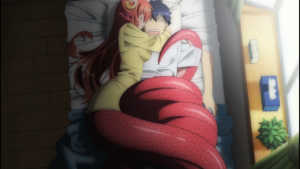 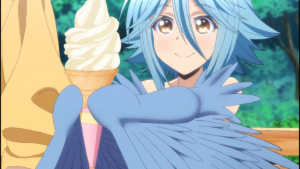 Monster Musume, however, treats the girls -- there are also monster guys, but this show being what it is, you don't get to see them nearly as often; Monster Musume is clearly created with men in mind -- more like an alien addition to the human world as we know it. While said introduction seemed to have gone rather well -- not surprisingly, part of that introduction is having a monster girl idol group called ANM48 -- the show, and its manga by extension, does occasionally show some of the less positive aspects of this hastily assembled conglomeration of human and monster people cultures. I was initially a bit dismayed when I found out that Monster Musume had, in essence, been turned into a harem show, and a particularly stereotypical one at that. It was, I felt, a step down from the endearing slice-of-life qualities Oyakado's original creation, which was more along the lines of what I wanted to see. The manga would eventually win me over with how it presented its monster cast, and the way it built a lot of its comedy around that, and so I could go into this anime with a lot more optimism. But yes, I'm going to have to play the "it is what it is" card here again; Monster Musume is a harem first and foremost, and if you don't care for that sort of thing -- and I mean really don't care about it -- Monster Musume might not win you over. Not that I'm overly fond of harems myself, but that's usually more because most of them tend to treat its main audience like idiots or feed on their massive sense of entitlement. Our main lead, Kimihito, might also sort of fit in with your everyday nice guy, but he's given enough of a personality where he is your average nice guy, but also not afraid to voice his displeasure with the girls when they step over the line. He's supportive and kind, much in the same way as the main lead in Outbreak Company was, though his situation is a bit different. In contrast, the monster girls often bring their own cultures into the equation, which color their everyday actions. Miia, which comes from an all-female tribe, must rely on men from other races for procreation, so she's unabashedly passionate and aggressively sexual. According to the manga, the lamia race tended to kidnap human males and engage in some pretty heavy-duty snake orgies, which was one of the first things that had to go when the human beings and the monster races aimed for coexistence. Then there's Papi, the member of yet another all-female race, the Harpies. Being birds, she tends to act more childish and carefree, and unlike most of the other monster girls, has a slim build and a relatively petite chest to go with it, which actually makes a lot of sense when you consider that they have the ability to fly with their rather impressive wingspan. (4 meters in total, according to the manga.) Sure, it doesn't make any sense, scientifically, but in this case, I think it's alright to dispense with some disbelief for the sake of enjoying the show. The centaurs do have males in the monster family, but, given how the manga covered that particular area, it's no wonder why centaur females would rather look outside for marriage partners. The show -- and, again, the manga by extension -- chose to portray female centaurs as stout and honorable, giving them knightly virtues, more or less. Cerea, our leading centaur lady, does come across as a bit naive at times, her meeting with Kimihito being basically her taking stereotypical shoujo manga clichés like running to school with a piece of toast in her mouth and accidentally bumping into her destined partner as a "spell" of sorts. She's also possibly even stronger than Miia and her boa constrictor tail, and as such, technically an even bigger danger to Kimihito's continued well-being. With the possible exception of Tio, the ogre girl, she comes with the largest bustline among the monster girls, which the show explains in a way that actually makes sense -- centaur women give birth to large children, so they need large breasts to support the infants. The mermaid tribes also have males, technically, but the show's main addition is, unsurprisingly, a girl. Meroune isn't as direct a threat as the others, at least not physically, but she tends to forget that human beings can't breathe in water. She's got a very formal way of carrying herself, and I have to say that the anime did her all the favors by giving her an actual voice; it's sweet as all hell, to the point where I was actually taken a bit aback because of it. Her clothing style seems to favor "gothic lolita", and she's also the source of the show's -- and, yes again, the manga by extension -- funniest repeat joke; her fetish for tragedy romances. She's a huge fan of "The Little Mermaid", and apparently, one of her dreams is being caught up in an unrequited love and being turned into sea foam because of it. She immediately takes an interest in Kimihito's love life, which also as immediately puts her at odds with Miia. Her introduction was more or less spearheaded by the appearance of Suu, the slime girl, and easily the most adorable addition to the show. Like Meroune, she seems to have some problems understanding the human need for respiration, but she goes from basically having a near complete lack of sentience to being a fully functional member of the family. Her kind isn't officially recognized among the monster races, which earns her a surprisingly easy access into Kimihito's ever expanding family courtesy of Smith's hilariously unprofessional disinterest in dealing with her. Her appearance also clued us in on one of the more positive aspects of Papi's personality; her fierce protectiveness and willingness to look after beings like Suu, who would otherwise be completely lost in red tape of all the paper mills in this world. Suu, on the other hand, quickly learns from all of them, mostly for the better, but also occasionally from the hilariously "worse". She is the mystery girl of the group, and also the other source of the best comedy the show has to offer; like when she tests wild plants for poison for the sake of the others (by turning her head tentacle thing into an X or an O, regarding on whether it's safe for humans to eat), and the accumulating poison not only changing her coloring somewhat, but also giving her a bit of poisonous tongue for a while. She's also often looking for water, and can use that to change her form between a mid-teenage one (like Papi) or a vastly more voluptuous one. There is a ton of fanservice and sexual situations in Monster Musume, somewhat hilariously censored by the Crunchy stream I perused for this review -- though I'm assuming that the eventual DVD release will be completely uncensored -- and I guess one of the positive aspects of it is that the show is so shameless about it without saying it's something to be ashamed of. There is a sense of levity about the whole concept -- with Miia being openly sexual, Cerea being more reserved in that area and Meroune injecting her own weird brand of romantic overtures into the mix -- but the show takes it seriously enough that sexual encounters between humans and monster people are topics that needs to be worked out for the benefit of all parties. One wouldn't think so immediately, what with all the bodily harm Kimihito is getting into even when bedroom shenanigans were strictly verboten by law, but that falls more under the realm of physical comedy. I guess, by the show's standards, it technically still is, as Kimihito becomes more of a test subject when he's asked to pick a bride among the girls. Which was another part that worried me at first. Our main male lead gets into a lot of situations where he is severely hurt. In fact, the show itself makes a joke out of how he's in constant mortal peril, which is actually how it -- and, well... you know -- introduces the last addition to the household. But unlike... say, Love Hina's slapstick shenanigans, there is nothing malicious about the near constant harm Kimihito gets into, and so I was able to accept it for what it is. There is supposedly a law made that bans all kinds of violence between the two races, which sounds sensible at first glance, but kind of points out one of the problems I have with Monster Musume: it puts the monster people at a rather severe disadvantage. Not just because the girls are causing our main lead a lot of (unintentional) harm, but it sort of gives the humans carte blanche opportunity to harass the monster girls without them being able to do much about it. The show does go into this at some point after it introduces us to the arachnid, Rachnee; when a group of asshats are sexually assaulting Cerea under threat that they'd report her if she fights back, Rachnee gets one of her grand scenes when she interjects and wisely points out that it's alright to do what she has to to protect herself, because what are they going to do? Report that they were hurt when they tried molesting a monster girl? The reason why the scales are so uneven is because monster people face deportation if they do something to break said law, but the humans do not face that problem, of course, since the show takes place in the human realm. Either way, the awkward way this law is set up and needs to be worked on or around at times becomes kind of appropriate given that it's very true to life, whether this was the show's intention or not. 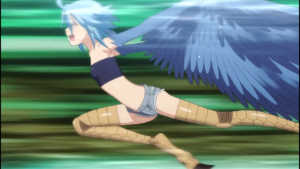 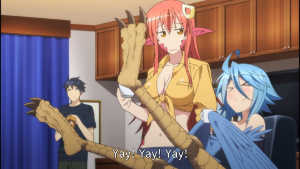 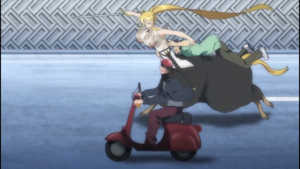 On that note, that's another thing the show doesn't really explain: where are all these girls coming from? Some later clues in the manga gave me some hints that the mermaids have always lived in our oceans. The manga also pointed out that the female-only tribes have relied on human males even before the events that lead to the cohabitation operation, which means that the monster people are earthlings too, despite their alien appearances. Going back to the law, there's also one that says the monster people can't go anywhere without having their human homestays with them, which also strikes me as weirdly unfair. I'd like to think that this law isn't made just to make sure Kimihito is always surrounded by girls at almost all times, but it does carry an undercurrent of "stay at home girls". Though the show does make exceptions, apparently, since Kimihito's meeting with Cerea was with her moving outside on her own, apparently on a special approved leave. Either way, it's a rather odd law that doesn't make much sense, though the show does admit that most of the laws were made very much on the fly and is in sore need of alterations to work out the best for all parts. The art and animation in this show has been given a surprising amount of care. Given the sheer popularity of the manga, it's not necessarily unexpected, but character designs have been consistent and well made, mirroring the manga's equally nice art to a satisfying degree, and it's nice to see that animation companies are willing to go beyond the bare minimum just to satisfy people who want to see boobs. Some scenes get a bit fuzzy, but I suspect that has more to do with the show's odd way of censoring itself by cropping out objectionable parts from the whole picture and expanding the rest to cover the screen than any lack of effort on the animators' part. It's not great animation, necessarily -- some of the scenes with, say, Kimihito dangling from Miia's tail grip looks kind of awkward in a CGish way -- but with the help of the director, Yoshihara Tatsuya, who has also worked on, amongst other stuff, Muromi-san -- the show looks pretty good on average, and I'd even upgrade some of those segments to damn good. Like Cerea's introduction, where she and Kimihito pursues a purse snatcher on a scooter in what is a pretty well-made chase scene, or the scene where Kimihito lands a solid punch on a guy who was making fun of Miia. Mr. Yoshihara does make some... creative directional choices that comes into more of its own thing rather than being in the style of the manga, but not in a way that takes me out of the show. In what's more of a downside, that also means the show feels kind of like it's rushing through its plot points at times. This might not necessarily be the director's fault, even if Muromi-san was a high-octane rush from beginning to end, as each episode must run in at 24 minutes, and the anime tends to cover two chapters per episode. It does, however, give me this mild feeling that the characters are basically rushing through their lines so that they can play out their parts in time. Most of the times, it works, particularly during the more action-y bits (like the aforementioned scooter chase scene), but the show has a lot of quieter moments too, and I just think the show would have been better served having been allowed to linger a bit more during those moments. 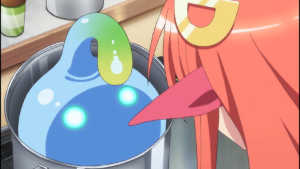 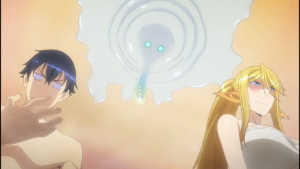 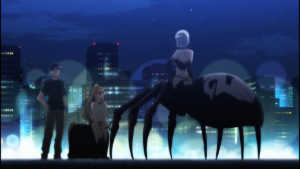 That said, taken in as a whole, Monster Musume is a whole lot of fun, mostly because it never really loses sight of the whole "monster" part of the equation, but instead weaving it into the comedy as it goes along. This also helps the show put some distance between its rather dreary harem build by strength of this weird disconnect between the fact that all of the girls that take an interest in Kimihito are part sexy girl and part alien monstrosity, which becomes blatantly clear from the get-go, where Kimihito wakes up in the morning and look straight into Miia's pretty face before zooming out and giving the audience a look at her seven meter snake tail. I'm even iffy about describing the girls as monsters -- regardless of Miia's aforementioned tail, or Papi's huge clawed raptor feet, or even Cerea basically having the lower body of a horse (which will make the wedding night kind of awkward, I bet) -- because, despite all the damage they do due to their lack of control over their physical strength, there is a certain sweetness to it all. Miia's sense of devotion, Papi's sense of protection, Cerea's sense of honor -- they all have positive qualities that puts the word "monster" somewhat at odds with the characters they're used for, though even the show is self-aware enough to realize -- and joke about -- the fact that not long ago, girls like Miia and Papi would be enemies in RPGs, there to be defeated with the aid of cutlery or magic. Monster Musume is obviously not a masterwork -- it is what it is -- but it has a pretty perfect mix of self-awareness and sense of fun about itself, so much like I did with the second season of High School DxD, very much an appropriate companion piece to Monster Musume, I give this my full seal of approval. It's both ridiculous and sexy, alien and weird, and a friendly introduction to bodily harm and monster girl biology. And it's fun. — Stig Høgset Recommended Audience: The show's sexual content puts it squarely out of the reach of anyone under the age of 15, maybe even 18 -- I mean... the show starts with the male lead masturbating the tail of our resident lamia girl until she loudly proclaims she's... arriving at the scene, and continues to shamelessly flaunt the full range of naughty fun from that point forth, even in the face of the stream's hilarious attempts at self-censorship. Some people might also find obviously sexual scenes starring Papi, like her eating a phallic-looking ice cream or laying an egg, to be a bit off putting, which depends on whether you think her behavior is infantile or just airheaded. Version(s) Viewed: Digital stream on Crunchyroll, Japanese with English subs Review Status: Full (12/12) Monster Musume © 2015 Lerche, Seva |
 |
|
| © 1996-2015 THEM Anime Reviews. All rights reserved. |